Tian Zhou
Bridging Past and Future: Distribution-Aware Alignment for Time Series Forecasting
Sep 17, 2025Abstract:Representation learning techniques like contrastive learning have long been explored in time series forecasting, mirroring their success in computer vision and natural language processing. Yet recent state-of-the-art (SOTA) forecasters seldom adopt these representation approaches because they have shown little performance advantage. We challenge this view and demonstrate that explicit representation alignment can supply critical information that bridges the distributional gap between input histories and future targets. To this end, we introduce TimeAlign, a lightweight, plug-and-play framework that learns auxiliary features via a simple reconstruction task and feeds them back to any base forecaster. Extensive experiments across eight benchmarks verify its superior performance. Further studies indicate that the gains arises primarily from correcting frequency mismatches between historical inputs and future outputs. We also provide a theoretical justification for the effectiveness of TimeAlign in increasing the mutual information between learned representations and predicted targets. As it is architecture-agnostic and incurs negligible overhead, TimeAlign can serve as a general alignment module for modern deep learning time-series forecasting systems. The code is available at https://github.com/TROUBADOUR000/TimeAlign.
Utilizing Strategic Pre-training to Reduce Overfitting: Baguan -- A Pre-trained Weather Forecasting Model
May 20, 2025Abstract:Weather forecasting has long posed a significant challenge for humanity. While recent AI-based models have surpassed traditional numerical weather prediction (NWP) methods in global forecasting tasks, overfitting remains a critical issue due to the limited availability of real-world weather data spanning only a few decades. Unlike fields like computer vision or natural language processing, where data abundance can mitigate overfitting, weather forecasting demands innovative strategies to address this challenge with existing data. In this paper, we explore pre-training methods for weather forecasting, finding that selecting an appropriately challenging pre-training task introduces locality bias, effectively mitigating overfitting and enhancing performance. We introduce Baguan, a novel data-driven model for medium-range weather forecasting, built on a Siamese Autoencoder pre-trained in a self-supervised manner and fine-tuned for different lead times. Experimental results show that Baguan outperforms traditional methods, delivering more accurate forecasts. Additionally, the pre-trained Baguan demonstrates robust overfitting control and excels in downstream tasks, such as subseasonal-to-seasonal (S2S) modeling and regional forecasting, after fine-tuning.
Maximizing the Impact of Deep Learning on Subseasonal-to-Seasonal Climate Forecasting: The Essential Role of Optimization
Nov 23, 2024Abstract:Weather and climate forecasting is vital for sectors such as agriculture and disaster management. Although numerical weather prediction (NWP) systems have advanced, forecasting at the subseasonal-to-seasonal (S2S) scale, spanning 2 to 6 weeks, remains challenging due to the chaotic and sparse atmospheric signals at this interval. Even state-of-the-art deep learning models struggle to outperform simple climatology models in this domain. This paper identifies that optimization, instead of network structure, could be the root cause of this performance gap, and then we develop a novel multi-stage optimization strategy to close the gap. Extensive empirical studies demonstrate that our multi-stage optimization approach significantly improves key skill metrics, PCC and TCC, while utilizing the same backbone structure, surpassing the state-of-the-art NWP systems (ECMWF-S2S) by over \textbf{19-91\%}. Our research contests the recent study that direct forecasting outperforms rolling forecasting for S2S tasks. Through theoretical analysis, we propose that the underperformance of rolling forecasting may arise from the accumulation of Jacobian matrix products during training. Our multi-stage framework can be viewed as a form of teacher forcing to address this issue. Code is available at \url{https://anonymous.4open.science/r/Baguan-S2S-23E7/}
Guided MRI Reconstruction via Schrödinger Bridge
Nov 21, 2024



Abstract:Magnetic Resonance Imaging (MRI) is a multi-contrast imaging technique in which different contrast images share similar structural information. However, conventional diffusion models struggle to effectively leverage this structural similarity. Recently, the Schr\"odinger Bridge (SB), a nonlinear extension of the diffusion model, has been proposed to establish diffusion paths between any distributions, allowing the incorporation of guided priors. This study proposes an SB-based, multi-contrast image-guided reconstruction framework that establishes a diffusion bridge between the guiding and target image distributions. By using the guiding image along with data consistency during sampling, the target image is reconstructed more accurately. To better address structural differences between images, we introduce an inversion strategy from the field of image editing, termed $\mathbf{I}^2$SB-inversion. Experiments on a paried T1 and T2-FLAIR datasets demonstrate that $\mathbf{I}^2$SB-inversion achieve a high acceleration up to 14.4 and outperforms existing methods in terms of both reconstruction accuracy and stability.
Mitigating Time Discretization Challenges with WeatherODE: A Sandwich Physics-Driven Neural ODE for Weather Forecasting
Oct 09, 2024Abstract:In the field of weather forecasting, traditional models often grapple with discretization errors and time-dependent source discrepancies, which limit their predictive performance. In this paper, we present WeatherODE, a novel one-stage, physics-driven ordinary differential equation (ODE) model designed to enhance weather forecasting accuracy. By leveraging wave equation theory and integrating a time-dependent source model, WeatherODE effectively addresses the challenges associated with time-discretization error and dynamic atmospheric processes. Moreover, we design a CNN-ViT-CNN sandwich structure, facilitating efficient learning dynamics tailored for distinct yet interrelated tasks with varying optimization biases in advection equation estimation. Through rigorous experiments, WeatherODE demonstrates superior performance in both global and regional weather forecasting tasks, outperforming recent state-of-the-art approaches by significant margins of over 40.0\% and 31.8\% in root mean square error (RMSE), respectively. The source code is available at \url{https://github.com/DAMO-DI-ML/WeatherODE}.
Less is more: Embracing sparsity and interpolation with Esiformer for time series forecasting
Oct 08, 2024Abstract:Time series forecasting has played a significant role in many practical fields. But time series data generated from real-world applications always exhibits high variance and lots of noise, which makes it difficult to capture the inherent periodic patterns of the data, hurting the prediction accuracy significantly. To address this issue, we propose the Esiformer, which apply interpolation on the original data, decreasing the overall variance of the data and alleviating the influence of noise. What's more, we enhanced the vanilla transformer with a robust Sparse FFN. It can enhance the representation ability of the model effectively, and maintain the excellent robustness, avoiding the risk of overfitting compared with the vanilla implementation. Through evaluations on challenging real-world datasets, our method outperforms leading model PatchTST, reducing MSE by 6.5% and MAE by 5.8% in multivariate time series forecasting. Code is available at: https://github.com/yyg1282142265/Esiformer/tree/main.
Unlocking the Power of LSTM for Long Term Time Series Forecasting
Aug 19, 2024


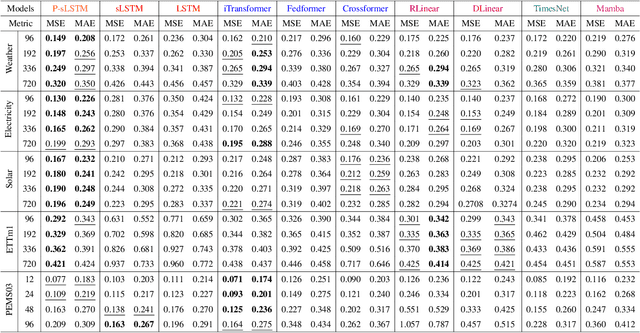
Abstract:Traditional recurrent neural network architectures, such as long short-term memory neural networks (LSTM), have historically held a prominent role in time series forecasting (TSF) tasks. While the recently introduced sLSTM for Natural Language Processing (NLP) introduces exponential gating and memory mixing that are beneficial for long term sequential learning, its potential short memory issue is a barrier to applying sLSTM directly in TSF. To address this, we propose a simple yet efficient algorithm named P-sLSTM, which is built upon sLSTM by incorporating patching and channel independence. These modifications substantially enhance sLSTM's performance in TSF, achieving state-of-the-art results. Furthermore, we provide theoretical justifications for our design, and conduct extensive comparative and analytical experiments to fully validate the efficiency and superior performance of our model.
S$^3$Attention: Improving Long Sequence Attention with Smoothed Skeleton Sketching
Aug 16, 2024Abstract:Attention based models have achieved many remarkable breakthroughs in numerous applications. However, the quadratic complexity of Attention makes the vanilla Attention based models hard to apply to long sequence tasks. Various improved Attention structures are proposed to reduce the computation cost by inducing low rankness and approximating the whole sequence by sub-sequences. The most challenging part of those approaches is maintaining the proper balance between information preservation and computation reduction: the longer sub-sequences used, the better information is preserved, but at the price of introducing more noise and computational costs. In this paper, we propose a smoothed skeleton sketching based Attention structure, coined S$^3$Attention, which significantly improves upon the previous attempts to negotiate this trade-off. S$^3$Attention has two mechanisms to effectively minimize the impact of noise while keeping the linear complexity to the sequence length: a smoothing block to mix information over long sequences and a matrix sketching method that simultaneously selects columns and rows from the input matrix. We verify the effectiveness of S$^3$Attention both theoretically and empirically. Extensive studies over Long Range Arena (LRA) datasets and six time-series forecasting show that S$^3$Attention significantly outperforms both vanilla Attention and other state-of-the-art variants of Attention structures.
FusionSF: Fuse Heterogeneous Modalities in a Vector Quantized Framework for Robust Solar Power Forecasting
Feb 08, 2024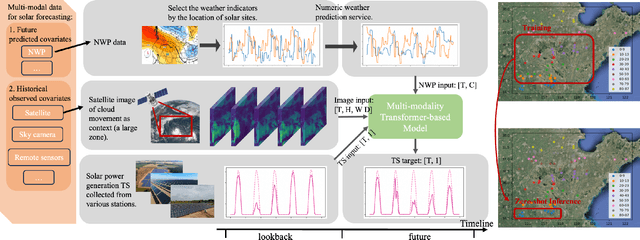
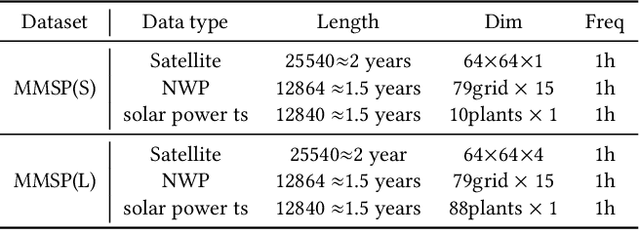
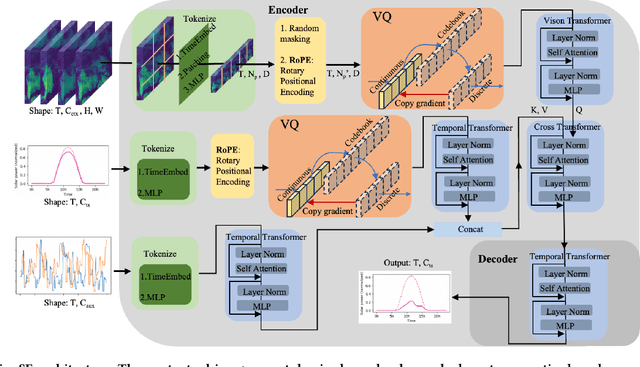
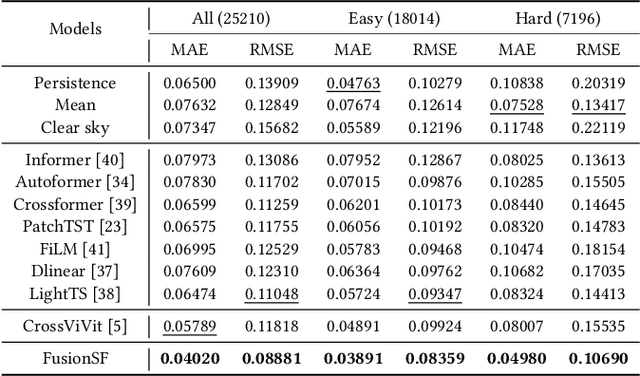
Abstract:Accurate solar power forecasting is crucial to integrate photovoltaic plants into the electric grid, schedule and secure the power grid safety. This problem becomes more demanding for those newly installed solar plants which lack sufficient data. Current research predominantly relies on historical solar power data or numerical weather prediction in a single-modality format, ignoring the complementary information provided in different modalities. In this paper, we propose a multi-modality fusion framework to integrate historical power data, numerical weather prediction, and satellite images, significantly improving forecast performance. We introduce a vector quantized framework that aligns modalities with varying information densities, striking a balance between integrating sufficient information and averting model overfitting. Our framework demonstrates strong zero-shot forecasting capability, which is especially useful for those newly installed plants. Moreover, we collect and release a multi-modal solar power (MMSP) dataset from real-world plants to further promote the research of multi-modal solar forecasting algorithms. Our extensive experiments show that our model not only operates with robustness but also boosts accuracy in both zero-shot forecasting and scenarios rich with training data, surpassing leading models. We have incorporated it into our eForecaster platform and deployed it for more than 300 solar plants with a capacity of over 15GW.
Sparse-VQ Transformer: An FFN-Free Framework with Vector Quantization for Enhanced Time Series Forecasting
Feb 08, 2024



Abstract:Time series analysis is vital for numerous applications, and transformers have become increasingly prominent in this domain. Leading methods customize the transformer architecture from NLP and CV, utilizing a patching technique to convert continuous signals into segments. Yet, time series data are uniquely challenging due to significant distribution shifts and intrinsic noise levels. To address these two challenges,we introduce the Sparse Vector Quantized FFN-Free Transformer (Sparse-VQ). Our methodology capitalizes on a sparse vector quantization technique coupled with Reverse Instance Normalization (RevIN) to reduce noise impact and capture sufficient statistics for forecasting, serving as an alternative to the Feed-Forward layer (FFN) in the transformer architecture. Our FFN-free approach trims the parameter count, enhancing computational efficiency and reducing overfitting. Through evaluations across ten benchmark datasets, including the newly introduced CAISO dataset, Sparse-VQ surpasses leading models with a 7.84% and 4.17% decrease in MAE for univariate and multivariate time series forecasting, respectively. Moreover, it can be seamlessly integrated with existing transformer-based models to elevate their performance.
 Add to Chrome
Add to Chrome Add to Firefox
Add to Firefox Add to Edge
Add to Edge